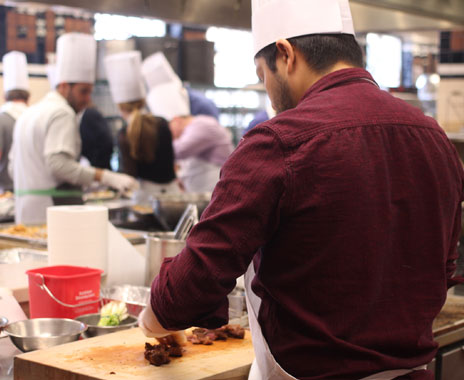For years, the build-your-own-dish model has been the focus of many fast-casual brands, from sandwich and taco brands to those serving poké and grain bowls.
That customization approach was a point of discussion for many attendees at Disrupting Fast Casual, an educational event co-hosted by QSR, Avocados from Mexico, and CIA Consulting at The Culinary Institute of America’s (CIA) campus in Hyde Park, New York, in April. Attendees from brands around the world were tasked with revamping four fast-casual concept ideas that had been developed by students at the CIA.
During the collaboration process, the decision on whether to make menu items customizable—and to what extent—came up, and brand representatives had varying opinions on what to do. Some said customization is past its prime, and that guests need and want guidance from the restaurant on what the best combinations are. Others said customers want control and enjoy variety, and that restaurant staff should assist in the customization process.
For some fast-casual brands, it works. Customization can bring in more guests and allows them to feel as if they have control over their food experiences. For other restaurants, it bumps up ticket wait times, can cause problems in the kitchen, and can even lead to combinations that guests may find unappetizing at best.
Attendee Brian Wiles, chief operating officer of Rise Biscuits Donuts, pointed out that for the breakfast concept, customization is an advantage. The fast casual offers a set of specials that change regularly—including combinations like a fried green tomato biscuit with pimento cheese and arugula—but it also has a core set of items that guests can combine themselves, from bacon and sausage to fried eggplant and avocado spread.
At Disrupting Fast Casual, Dan Kish, the former head chef of Panera Bread and founder of Food-Fixe—and one of the event’s concept captains leading collaboration—said during a presentation that perhaps the best menu balance for fast-casual brands is “curation with optionality.”
Brands like Chipotle and Subway have built entire concepts around customization with food options that almost always pair well. But what if menu items aren’t as simple as a bowl, biscuit, or sandwich? What happens when restaurants start tossing in assembly line masago and unfamiliar sauces? You may inevitably end up with a group of customers Googling yuzu kosho at your local poké shop while the line gets longer and longer.
When customization enters the realm of complex and more plentiful menu items, it may become more difficult for guests to make decisions. Brands then have to rely on staff and their own menu combinations to ensure guests have a pleasant experience.
At California-based Sweetfin Poké, guests come in and can pick a fish, a sauce, and a base before selecting from a variety of add-on ingredients. Sweetfin’s executive chef Dakota Weiss, another concept captain at Disrupting Fast Casual, said during the event that there’s every possibility that a guest can come in and make a “ridiculously disgusting bowl,” but it’s up to the staff to guide them through the process and not allow that to happen.
“If you mix the avo-coco sauce with the creamy togarashi sauce, it’s going to taste like vomit; there’s no way around that,” Weiss says. “It’s a part of training your staff just to say something like, ‘Maybe we’ll do the avo-coco sauce in the bowl and the creamy togarashi on the side.’”
While other segments, particularly casual-dining chains, are racing to pare down menus to cut cost and make kitchens more efficient, the fast-casual segment could be a pioneer in balancing curation and customization, and determining what impact that has on the guest experience.
We’d love to hear the ways in which customization works or doesn’t work at your concept; email your thoughts to alex@foodnewsmedia.com.









